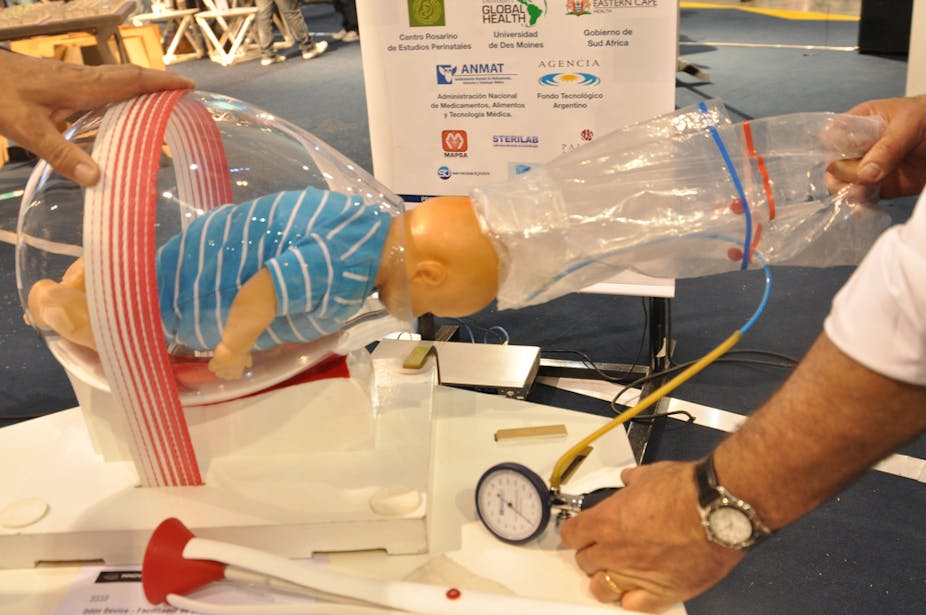There are three ways a baby can be born: a spontaneous vaginal birth where the mother pushes the baby out herself, an instrumental vaginal birth where forceps or vacuum extractors are used to pull the baby out, and a caesarean section.
Instrumental delivery is currently used when the birth is prolonged or the baby needs to be delivered quickly, for the mother’s safety or its own. In 2010, 4% of women giving birth in Australia had a forceps delivery and 8% had a vacuum birth.
While spontaneous birth and caesarean sections may get more attention, the history of birthing instruments is more colourful than you might think—from barber surgeons blindfolding mothers to motor mechanics inspired by YouTube.
The Odon device
Jorge Odon, an Argentinian car mechanic, has become big news after inventing a new tool to extract babies from the birth canal.
Inspired by a YouTube video (like this one) demonstrating the extraction of a lost cork from a wine bottle, he practiced the technique using a glass jar for the uterus and his daughter’s doll for the baby.
The device involves a plastic bag placed inside a lubricated plastic sleeve that is slipped over the baby’s head in the birth canal, inflated so it grips the head, and then pulled.
Women everywhere crossed their legs in response.
But despite its strange beginnings, the Odon device is not a joke. The World Health Organization has even showcased the device, claiming that it may be safer than forceps or vacuum extractors.
However, the device has only been tested on 30 Argentinian women, who had all given birth before and were experiencing normal labours. In other words, it was tested on a group of women who are least likely to require assistance in birth.
Until an adequately rigorous randomised, controlled trial is carried out, comparing the device to the instruments in current use (forceps and vacuum extractors) we should remain cautious.
Forceps
Until the 1600s, midwives had only their hands or crude instruments to facilitate difficult births. The mother may have laboured for days, the baby usually would have died and destructive instruments or even kitchen utensils were often used to extract the baby and save the mother’s life.
Forceps were invented in medieval Europe by the Chamberlens, a family of barber surgeons (a type of surgeon who often tended to the war wounded). These metal instruments (a bit like salad servers) are inserted into the woman’s vagina, placed either side of the baby’s head and then locked together and pulled to expedite the birth.

The Chamberlen forceps were carried in a gilded chest and only revealed once the woman was blindfolded. The whole operation would take place underneath a blanket with only the Chamberlens in attendance, allowing them to keep the practice a secret for more than 100 years.
It is believed that at some point, the instruments were sold to a Dutch obstetrician by a grandson of the original Chamberlen brothers.
Other secret models began to appear from the 18th century onwards. But the forceps we use today are remarkably similar to the original Chamberlen forceps.
The vacuum extractor
The concept of the vacuum extractor is said to have come from the ancient technique of cupping, where suction is applied to the skin in order to promote blood flow. Modern day vacuum extractors work by placing a metal or plastic cup on the baby’s head, creating a suction and then pulling the baby out.
James Simpson developed the first successful vacuum extractor, called the “air tractor”, in 1849. It was not until the 1950s that the first steel cup device was developed. By the 1980s, soft cups and handheld vacuum pumps came into use.
Today, vacuum extractors are used far more frequently than forceps.
Minimising risk
There are different risks associated with both forceps and vacuum extractors.
In 2010, a systematic review including 32 randomised controlled trials reported that forceps were more likely to achieve a vaginal birth than vacuum extraction.
However, with forceps, there was an increase in severe tears of the mother’s perineum (involving the anal sphincter), incontinence and facial injury for the baby.
Vacuum births are also not without risk, leading to more scalp injuries and cephalohematoma for the baby (swelling due to bleeding in the skull).
With a greater incidence of trauma to the mother and baby than spontaneous birth, we need to look at ways to minimise the use of instruments during birth.
We know that first-time mothers are more likely to have an instrumental birth, especially if they are older. A study our research team undertook this year showed certain migrant groups, particularly Indian women, had a higher rate of instrumental birth.
The scientific evidence also indicates the chance of needing forceps or vacuum extraction for birth increases with epidural anaesthesia use and continuous electronic fetal monitoring.
We know the risk of instrumental birth is reduced with midwifery-led models of care, where there is continuous support in labour, and giving birth in a homelike environment like a birth centre. The rate of instrumental birth is nearly twice as high in private hospitals in Australia compared to public hospitals.
No matter how appealing the Odon device may seem, all new technology must be evaluated with sufficient research before implementation. In the mean time, we should work on reducing the need for instrumental births to ensure the safety of mothers and babies.

